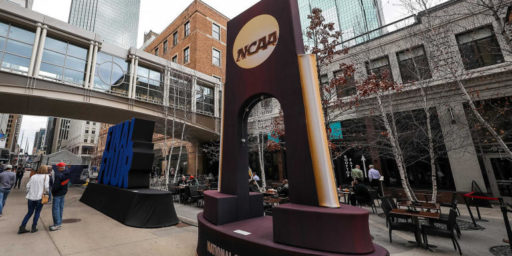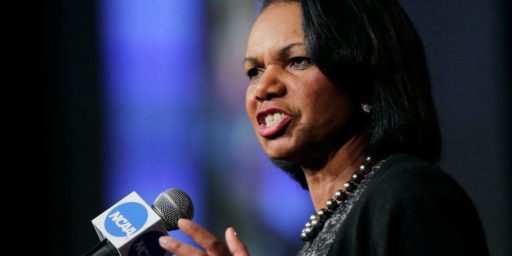The Future of College Sports
Faux amateurism is dead. What replaces it remains to be seen.

Last week, the NCAA and the major athletic conferences reached a settlement in a class action suit filed by former players. The “amateur” era is officially over for the revenue sports but the future is all but clear.
NPR (“What we know and what we don’t about a historic settlement to pay college athletes“):
A sea change is coming to college athletics.
On Thursday, the NCAA and the so-called “power five” athletic conferences reached a groundbreaking agreement that seeks to end the century-old tradition of amateurism in college sports by allowing athletes to receive pay directly from the colleges and universities they play for.
[…]
The proposed settlement has two parts. First, it would distribute some $2.75 billion to athletes who competed before July 2021, when the NCAA first allowed athletes to earn money from their name, image and likeness rights. Second, it would create a future revenue-sharing model in which schools could each distribute around $20 million per year directly to athletes.
But far from closing the door on the years of debates and litigation over the question of payments to student athletes, the proposed settlement raises a slate of even more questions: Which athletes will be compensated? How much will they make? Will women be paid equally to men? Will schools that are unable to pay athletes be able to keep up with bigger, richer schools?
ESPN’s Pete Thamel (“NCAA settlement a historic day for paying college athletes. What comes next?“):
The more than $2.7 billion of back damages and a new revenue-sharing model that come with the settlement of House v. NCAA and two related antitrust cases mark a distinct pivot for college sports. Amateurism, long a fragile and fleeting notion in the billion-dollar college sports industry, is officially dead. College sports, long a fractured group of fiefdoms, came together in an attempt to save themselves, with the jarring sight of five power leagues and the NCAA together on a press release.
This is a necessary and important week for the business of college athletics, yet not a celebratory one for its leaders. It’s a promising day for future athletes who are being compensated with revenue sharing expected to be more than $20 million per school.
And it’s also a confusing week for the coaches and leaders on campus, who have no idea what the specific rules of engagement are moving forward.
[…]
The peace that NCAA and conference leaders hope they are purchasing with their billions in settlement money is seemingly tentative. While the settlement will make it harder for plaintiff attorneys to wield the threat of billion-dollar damages in the future, athletes will have options to keep challenging any restriction or cap on how they are paid. As the final yes votes were being collected this week, a separate federal case in Colorado — Fontenot v. NCAA — continued to march forward on its own track, leaving open the possibility that NCAA lawyers won’t have time to catch their breath before fighting the next battle on capping athlete compensation.
[…]
We’ve outlined the lingering questions that will need to be hammered out. Most of the decisions to this point have been guided by the NCAA, lawyers and commissioners, and there will be a point when the actual participants in the weeds of the sports — the athletic directors and coaches — have a voice in the process. Or at least they hope to.
[…]
Without help from Congress, it will remain a bumpy road for the NCAA to enforce the kinds of rules it thinks are necessary to restore stability to college sports.
How does Title IX factor into the financial calculus? That looms as the biggest campus worry. How will rosters be constructed? Football coaches who have 130 players on their team — 85 scholarships and 45 walk-ons — are wondering if they need to cut a third of the roster with the expected inclusion of roster caps.
Pete Nakos, On3 (“‘New baseline compensation:’ Why revenue sharing makes NIL collectives, sponsorships imperative for competitive advantage“):
The top-funded collectives are spending between $13 to $20 million annually on football rosters at the moment. In basketball, the highest spending programs are pushing $5 million. Despite the NCAA trying to minimize the role of collectives in college sports, multiple sources and stakeholders tell On3 that the revenue-sharing cap will only necessitate organizations to strike side NIL deals to provide a competitive advantage.
“That cap is a very important piece because as we know the competitive nature of the collegiate athletics landscape, particularly in the Power Four, it’s going to necessitate additional dollars in order to recruit and retain the best athletes,” said Andrew Donovan, the President of Altius Sports Partners, which advises double-digit power conference athletic departments.
“If we’ve learned anything over the past three years, it is that schools are incredibly competitive. They’re going to do everything they can and their supporters are going to do everything they can to try to gain an advantage. And so, I think to expect that collectives are going to go away entirely would be a bit of a fool’s errand.”
Recent courtroom losses have rendered the NCAA’s transfer portal and NIL policies useless. As part of the settlement agreement, the NCAA is hoping to establish a new enforcement entity with court backing to limit the role of collectives. Even if a settlement lays out that framework for the next enforcement arm of college sports, Congress will need to step in. State laws will continue to supersede the settlement without lawmakers’ help.
Talks of a college football Super League have ramped up in recent months. The Big Ten and SEC recently formed a joint advisory group. Plenty of questions remain about what the sport will look like moving forward.
For example, if every Power Four quarterback receives $500,000 annually through their school’s revenue, many believe collectives will be imperative to offering the extra $200,000 to win a recruitment.
Stewart Mandel, The Athletic (“Paying college athletes will usher in a new era of uncertainty. But here’s what won’t happen“):
Fans will not stop watching college football
It’s the doomsday scenario NCAA attorneys, expert witnesses and certain fans have been threatening for years: The public will lose interest in college sports if the athletes are ever compensated beyond their scholarships.
“If we go down the road of paying players substantial sums, all will be lost,” former CBS Sports president Neal Pilson testified during the 2014 O’Bannon v. NCAA trial. Citing misleading public opinion polls the NCAA invoked during the case, he predicted viewership would fall by 15 to 20 percent.
Well, we have nearly three years of data now that confirms this argument was complete bunk.
[…]
People will keep watching college football because A) there is no greater loyalty in American sports than a person’s favorite college and B) fall Saturdays remain awesome.
The athletes’ academic experience will not be affected
The NCAA for years framed its arguments for preserving amateurism as a noble-minded attempt to protect its “student-athletes.”
“It is incredibly important that we … protect the amateurism of college sports and support rather than detract from the student-athlete’s educational experience,” former NCAA president Mark Emmert said in testimony before the Senate in 2020.
That would be well and good if it had actually been happening. If we completely ignored the decades-old practices of steering athletes to the easiest possible classes; “clustering” high percentages of athletes into easier majors; athletes spending far more than the supposed 20-hour-a-week limit on activities focused on their sport; embarrassing graduation rates; and, in certain cases, outright academic fraud.
[…]
People will not stop complaining about the state of things
College football is the rare phenomenon that is somehow both extremely popular yet extremely frustrating to its consumers on all variety of matters.
While I’ve heard all manner of fans claim that all of this is ruining the game, Mandel is right: if anything, the sport is more popular than ever. While the constant churn of players owing to the combination of multiple transfer windows a year and open bidding for players on other team’s rosters has downsides, it also makes college football a year-round event. There’s always news and excitement.
There is talk of Congress intervening, with Ted Cruz and others indicating that they want to take action. Aside from carving out a Title IX exception for the big revenue sports, which will be vital to saving the so-called Olympic sports, I doubt we’ll see much on that front.
I expect and hope to see some sort of super league for college football. Not only would it make sense financially, but it would also solve many of the other ills in the college sports landscape.
As much focus as we’ve seen on court-ordered player empowerment—their ability to get paid and transfer schools and play immediately—the thing that has been most damaging has been the destruction of historic regional conferences as schools have scrambled to maximize their share of television revenue for football. While that’s fine for big-time football, where teams play five or six road games a year, all in the fall semester, it’s been a disaster for sports with longer schedules, especially those that cross semesters. While Rutgers football can fly from New Jersey to Los Angeles once every few seasons to play USC, it makes no sense for their women’s softball or men’s lacrosse teams to do the same.
In my ideal world, the most successful 32 or 48 football schools would form a new football-only league and we could then restore a more regional look for all the other sports. Even men’s basketball pales in comparison financially to football and the lion’s share of the revenue it does generate in through the NCAA tournament, which thrives on regional conferences. While it will never happen, a European football-style relegation and promotion system would be a lot of fun, giving schools who missed the super league cut hope of getting there one day.
It’s also worth noting that, while talk of “amateurism” and “student-athletes” was quite rightly met with derision long before recent developments with regard to the highest levels of college football and basketball, they remain apt for the overwhelming number of collegiate sports. Even at the Alabamas, USCs, and Ohio States of the world, those who participate in the other sports subsist on partial scholarships, small stipends, and are full and true participants in the student body. And, at schools outside maybe the top 50 or 60 football and basketball programs, it’s true even in those sports. With rare exception, players at Troy and Appalachian State will hang up their uniforms for the last time at graduation.
UPDATE: I also meant to mention that, loathe though the Powers That Be are to do it, the only solution I see to the woes caused by the Transfer Portal and NIL combo is for the players to officially become employees of the universities and/or the aforementioned super league, establish some sort of collective bargaining entity, and have contracts.






Although it will never happen, I lke the “rest of the world” model, as opposed to the US model.
I’d prefer multiple levels of pro teams that can be relegated and promoted each year. If a sport cannot support itself financially this way, it deserves to stay amateur or semi-pro. The worldwide system of relegation and promotion is much better, in my opinion. Think of a world where the top three G-League teams get promoted to the NBA each year, and the bottom three NBA teams go down to the G-League. Or the top three AAA-Teams in Minor league baseball get promoted to MLB each season.
Our college sports system is f**ked beyond all repair. The top schools with big football programs are just revenue generators for the schools and NCAA (and the TV Networks) with zero having to do with academics or “student-athletes”. They’re entertainers creating a product to sell advertising on television.
And, as I’ve said befoe, I find it off-putting and sad that grown ass men and women spend so much time, attention, emotion, and money watching young men and women play sports.
@EddieInCA: We’re largely in agreement on this, probably fully in terms of big-time football. Most collegiate sports—swimming, softball, gymnastics, lacrosse, etc.—essentially have no professional level and others (volleyball, tennis, and golf come to mind) have very small pro leagues. I think it would be a shame to lose collegiate competition for those.
But, yes, revenue sports drive the train at too many state universities, including my doctoral alma mater. This is true even at elite “public Ivy” schools like Michigan, Berkley, Virginia, and North Carolina.
Leave the transfer portal in place as is, or separate those 32 or 48 schools? If we leave it in place, everyone outside those 32/48 schools is consigned to a feeder system, whose best players will transfer up after a season or two.
@Michael Cain: Absent some sort of contract system (see my update), there’s no avoiding that. It’s already a fact of life for the Group of Five schools now and, increasingly, it’s even true within the Power Four.
It’s good that athletes used by these programs are getting some money out of it. But let’s be honest. Big-time college football is a ludicrous somewhat-entertaining spectacle of money and bullshit which maybe makes sense if you’re one of 30 or so schools. The spectacle though can’t be contained. Brett Favre getting millions out of a welfare budget for freaking volleyball is what happens when people don’t blink at millions and millions for a football team which maybe has one or two future pros on it and has an unrealistic shot at making the playoffs.
Contrary to elite wisdom, state schools offer great educations. Who knows what’s going to happen in the future. The combo of hating academia and the humanities, and loving lavish productions might be the end of actual public education outside of a few holdouts.
This. It has never made sense to have the top division of football contain 130 teams. The roster size alone guarantees the vast majority of teams have little to no shot at competing with even the second tier of teams, much less the top tier.
@James Joyner:
the NCAA is doing everything it can to keep athletes from being declare employees because they fear collective bargaining.
@Sleeping Dog: IANAL, much less a labor attorney, but I just don’t see any alternative. SCOTUS has ruled that most NCAA rules violated the Sherman Antitrust Act and related statutes and Congress does not seem inclined to create a broad waiver. So, it’s either a Wild West situation where teams are tampering with players on other teams constantly or there are labor contracts and collective bargaining. I don’t see much way for there to be a median between those.
Have to see if my undergraduate school can make this work. The Athletic Department has been a separate legal entity from the University since the 1950s. State law does not allow the transfer of any money from either the state or the university to the department. Over the years there have been a variety of contractual work-arounds to meet the NCAA requirements for university control and federal Title IX regulations.
It’s good things are finally changing in this exploitative system, but I don’t see how you can have semi-pro and amateur college sports comingle, especially once you add complicating factors like Title IX.
What needs to happen is for college sports to return to its amateur roots by creating semi-pro leagues for viable sports that are peeled off like Eddie describes. Talent coming out of High School would then have a choice of competing for a semi-pro slot in which they are paid or going to college with the potential for a scholarship. All the best players would go semi-pro, and the money and audience would likely follow them because people want to see the best talent in the sports they enjoy. Schools could, perhaps, make money off this by licensing their names to semi-pro teams, but in my view, it would be better to have a clean break and return college sports to pure amateur status and get the corrupting influence of money of out of it entirely.
@James Joyner:
As an aficionado of sports programming (ESPN, BEIN, Sky Sports, Fox Sports), both domestically and abroad, I’m constantly amazed at how many professional leagues there are for minor sports. Additionally, there are professional leagues in other countries for sports most Americans have never heard of (Handball, or Korfball, for example.)
To name just a few off the top of my head:
Bowling
Handball
Roundnet aka Spikeball (Seriously? That’s a f**king sport???)
Lacrosse
Badminton
Futsal
Beach Soccer
Fencing
Netball (similar to basketball, and played mostly by women)
Korfball (cross between basketball and netball, which I saw played in Amsterdam.)
There are many more, but those are some I remember seeing on TV and in. In some countries, these sports we’ve never heard about draw very good crowds for matches.
PS – You’re correct that swimming and gymnastics have no pro leagues to speak of. But Lacrosse and Softball have an extensive numbers of professional leagues worldwide. There are two pro softball leagues alone in the USA. And nine Lacrosse pro leagues worldwide.
@Andy:
In the rest of the world, a kid who has talent from a very young age is funneled into a sports academy for the team that signs them. They then get the best training and sports medicine, along with having to go to school, with the focus being on them becoming a professional athelete. Most don’t make it (like our college kids in football and basketball), but they’re getting paid for their time and effort learning the craft of professional sports. There is no “amateur” sports overseas where kids can get exploited like they do in our college system.
David Beckham was signed by Manchester United when he was 15.
Luca Doncic was signed by Real Madrid when he was 13 – to a five year contract.
Kobe Bryant was 17 years old when he want to the NBA.
I would argue that college would have been bad for all three of these guys. Additionally, Caitlin Clark could have gone to the WBNA as a freshman. But our system precluded that. Look at how much money IOWA and ESPN made off of Caitlin Clark in the las two years. She deserved a piece of that.
The current system is broken, and I have no idea how to fix it because people in the USA love thier college football and March madness.
@EddIeInCA:
I agree, the way the rest of the world does it is better. Also agree that the big sticking point is the weird obsession with college sports.
I went to CU Boulder back when they were national champions. CU is a great school; I learned a lot there. But once I left college, I stopped caring about the Buffs for the same reasons I stopped caring about high school sports.
I don’t understand why people are so into their colleges years later, especially the sports teams. But I have to be respectful so many people are – I’m the weird one much of the time.
My best friends went to Penn State, and they are into their alma mater enough that they each have a tattoo, plus the usual stickers on their car. They host parties and the whole thing. I love them dearly, so I just say that I’m not into college sports, said the tattoo artist did a great job on the logo, and kept my mouth shut about how strange I think it is for professionals with masters and doctorates to be this into where they got their undergraduate degrees.
@EddIeInCA: If you charge admission and people pay it, yeah, it’s a professional sport. Being played by professionals automatically makes a competitive recreational activity a “sport.”
And you left out 3-ball billiards. A very popular sport in Korea, having both billiard parlors across the nation and televised professional matches.
@Andy:
Because
I didn’t do sports, so my boring stories are mostly from my days working produce warehousing (such as the one about threatening to leave a customer for dead in the wet cooler, for example–true story btw), but I also have a few from my less s0ciopathic days teaching in Korea. Fewer from my days teaching in the US but teaching in the US isn’t funny.
@Just nutha ignint cracker:
I left out alot of sports, but I was going from memory. Here’s a few others I thought of later.n
Darts in England
Shepherding in Wales and Scotland.
Cricket in India, Pakistan, and England.
Aussie Rule Football in Australia.
Rugby all over the world.
“Even men’s basketball pales in comparison financially to football and the lion’s share of the revenue it does generate in through the NCAA tournament, which thrives on regional conferences.”
I see this argument made often in some form or function. But I can’t quite wrap my head around it. I would think that Alabama football or UConn basketball is raking in money. They have all the same revenue streams as the pros (though I’m sure smaller) and, until now really, have avoided the one major expense that the pros have: player salaries. Which are generally around 50% of league revenue.
Some light Googling tells me the Alabama football program had a profit of $45M ($129M revenue and $83M expenses).
I couldn’t find specifics for the UConn Men’s basketball program.
I understand other programs aren’t going to do as well but I’d still think that television/media rights deals, sponsorships, and ticket sales would be major sources of revenue and the major expenses would be… staff salaries and travel, I guess?
@Kazzy: Yea, that was my point. There are maybe 30-40 schools that make a huge profit on football. Fewer, maybe 30, do so with men’s basketball and another handful on women’s basketball. I doubt any other sport makes money.
@EddIeInCA: Of course. But to be fair, everything but sheepherding has been recognized as an actual sport for centuries. And even in some parts of the US there are competitions about sheep dogs.
My suggestion is to form a 32 – 48 team league where the university simply sells the name of the university and provides the stadium and practice facilities which is maintained by the new league. Every player gets 5 full years of eligibility. The payers would not be students at all. Everything else sports would be intramural.
@James Joyner:
The Nebraska women’s volleyball team is profitable. They’re a freak, though. Their ticket revenue exceeds all women’s basketball programs except UConn’s.
@Michael Cain: I’m sure there are outliers. Once upon a time, North Carolina’s women’s soccer team was hugely popular and there are likely some gymnastics and baseball teams in a similar boat. But it’s getting harder and harder to be profitable, even if you’re popular, with conferences stretching from Camden, New Jersey to LA or Miami to Pullman, Washington.
Rick DeMent:
In addition to intramural sports, universities tend to also have a number of club sports. A club sport typically receives some material support from the university, but is a student-run organization that allows (or requires) the club members to fundraise to pay for equipment and other club expenses. Alumni and other boosters can be an important source of funding, but of course the club members themselves don’t get paid; in fact they typically have to pay club dues. Club teams travel and represent their school against other schools, and can be quite competitive.
https://www.espn.com/college-sports/story/_/id/39485967/sec-distribute-513m-per-school-22-23-fiscal-year
I’m curious how money like this gets factored into the equation. Is the $51M per school factored into numbers like the Alabama football team’s revenue from that year? Or is it somehow accounted for differently?
@Kazzy: I don’t know how Alabama distributes the money, most of which comes from television payouts for football and the NCAA basketball tournaments, but I’m sure football gets a huge chunk of it. And, yes, that’s absolutely factored into their revenue statement.
For 2022, for example, Alabama athletics reported $53,614,078 in media rights, $44,211,016 in ticket sales, and $12,223,365 in conference distribution.